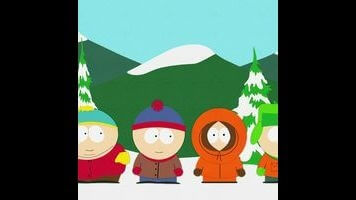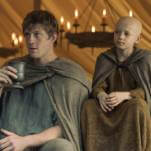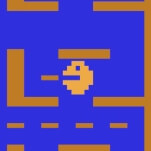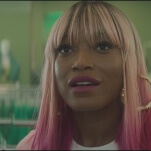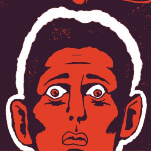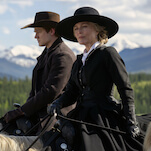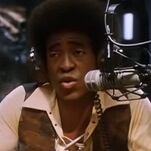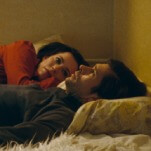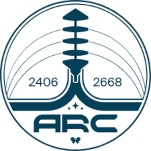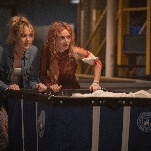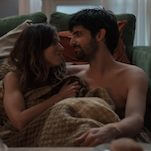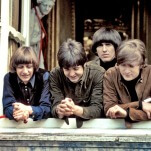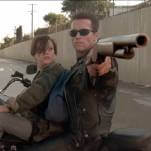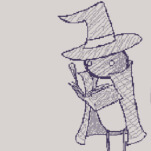Outside of a sparsely attended town hall meeting and a few tossed-off lines, Randy and company make little effort to fool the McCormicks, whose dilapidated home is right in the center of SodoSopa, into thinking that they’re doing this for the betterment of the poor. That unapologetic selfishness, that rabid desire to look good in front of other people no matter the cost, makes me think that “The City Part Of Town” isn’t really about gentrification at all. It’s about the current state of South Park.
The show has commented plenty of times before on its own age and the expectations (and complaints) from its audience, most effectively in “You’re Getting Old.” But that landmark episode was a totally different animal, rooted in Trey Parker and Matt Stone reflecting on their formula with a heavy sense of world-weariness. “The City Part Of Town” is far less defeatist, more playful and actively challenging towards the show’s detractors. A lot of that has to do with the B-story centered around Tuong Lu Kim/Dr. Janus (let’s just refer to him by the former name for simplicity’s sake), whose first scene finds him lamenting that people no longer care about him and his City (“shitty”) Wok. When he mentions customers’ distaste of his grating, offensive accent (remember, he‘s actually a white guy who only thinks he’s Asian) and states that he’s overstayed his welcome, he may as well be looking directly into the camera.
But Parker and Stone like to use stereotypes to prove a point, even when the stereotype in question is acknowledging how offensive they are, and some of the episode’s best moments come from the Kim narrative. As the presence of SodoSopa continues to push out the McCormicks, Kenny, along with an entire child-labor force of disenfranchised kids all too happy to work, picks up a job at City Wok. Even with his new employees in place, Kim’s restaurant is still floundering, so he tries to rebrand his neighborhood as its own yupster haven. But his commercial ends up being an unintentional inverse of the ads for SodaSopa, soothingly describing his product while the visuals expose the pile of greasy, deep-fried shit it actually is. At the same time, it’s no less valid than the lies being spewed out (at a nice, leisurely pace of course) by Randy, Mayor Henderson, and everyone else behind SodaSopa. In fact, it’s probably a little more noble (though not by much).
When the Whole Foods finally does open after one hell of a showdown between the adults and the child-labor force, the town’s one step closer to being a militarized Garden of Eden, a place where everyone’s forced to be happy and accepting all the time. It’s a sham, and a creepy one at that. During the commercial that closes the episode, we see uncharacteristic harmony between everybody as they stroll down the aisles of the grocery store. They’re all smiling, no matter the activity. Then a Mexican family enters looking terrified, as if someone is forcing them at gunpoint to shop somewhere they don’t want to shop. As the commercial ends, Cartman asks Kyle in a nasty whisper if the Mexicans are staying. Despite the harsh remark, everyone gives a blissed out wave to the camera. “Welcome home.”
The whole sequence comes off like a big fuck-you to the PC Police and other assorted critics of the show. It’s a challenge that says “You want a more tolerant South Park? Here it is.” Because when people in South Park try to be more tolerant, it usually leads to intolerance or, even worse, fake tolerance; fake improvement; fake diversity. “I’ve never seen a town put so much energy into displaying an exaggerated sense of social consciousness,” says the Gestapo-like Whole Foods representative. While that could be Parker and Stone taking a goodnatured jab at their own worldview, it really does sum up what their fictional universe has become. It’s a statement that’s far more complex and effective than just depicting the PC Police as a bunch of frat bros: Thanks to the South Park residents’ dangerous willingness to bend to whatever socially conscious trend they’ve been told is right, they’ve forgotten how to do what they simply know to be right. Even Kyle’s now guilty of this.
The one exception is Kenny, who, in the midst of all the socioeconomic warfare, saves his wages to buy his little sister a doll. This simple gesture is the sole instance of human warmth in the episode, lending a sense of sweetness to its final moments. Still, the last thing we see is that unsettling Whole Foods ad, which, along with the expanding power of the PC Principal, hints that South Park’s only going to get uglier from here.
Stray observations
- After a far-too-long absence of Office Barbrady, there he is dining with Harrison Yates! I never thought I’d see the day. Hopefully there’s a buddy-cop episode in their future.
- There are cameos from lots of other characters we haven’t seen in a while, too: Dr. Tom, Dr. Mephesto, Big Gay Al, etc. Maybe I’m reading too far into things, but it could be a conscious decision on Parker and Stone’s part to falsely present the show in what many view as its idealized version, the “glory years” when it took less risks in its social commentary in favor of dick and fart jokes.
- The use of live-action commercials has always been an effective device on South Park, and mixing the real actors with the animated versions of Kenny’s family only adds to the McCormicks’ financial and social alienation.
- Trey Parker really nails the cool, cloying lisp heard in the voiceovers of so many neighborhood ads. Casino commercials, too.
- I kept waiting for the Whole Foods rep to explode in anger at South Park’s decency standards not being up to his, but he never did, which was amusing.
- Does anyone know if that final commercial was parodying a specific Whole Foods ad? I watched a bunch of them, but couldn’t find anything too similar.
- “Thanks to Mr. Garrison, we are now being referred to as the shitheads of America.”
- “Come on inside. I’ll pay you the child-labor wage you deserve.”
- “I like you, Dennis.”
